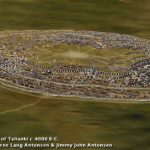(disclaimer: many human societies will cope just fine. The most advanced economies are the least resilient and deaths could be in the millions…)
Deep Space Climate Observatory, or DSCOVR, is the singular satellite that can tell us of an approaching solar storm, flare, coronal mass ejection (CME)… that can damage infrastructure on Earth like railway lines, power lines and pipelines. Things (and people) in space are even more vulnerable because there is no atmosphere to protect them.
When the next solar storm approaches Earth and the deep-space satellite provides its warning—maybe an hour in advance, or maybe 15 minutes, if the storm is fast-moving—alarms will sound on crewed spacecraft. Astronauts will proceed to cramped modules lined with hydrogen-rich materials like polyethylene, which will prevent their DNA from being shredded by protons in the plasma. They may float inside for hours or days, depending on how long the storm endures.
…As the atmosphere heats up, it will swell, and satellites will drag, veer off course, and risk collision with each other and space debris. Some will fall out of orbit entirely. Most new satellites are equipped to endure some solar radiation, but in a strong enough storm, even the fanciest circuit board can fry. When navigation and communication systems fail, the commercial airline fleet—about 10,000 planes in the sky at any given time—will attempt a simultaneous grounding. Pilots will eyeball themselves into a flight pattern while air traffic controllers use light signals to guide the planes in.
…the electricity coursing through the atmosphere will begin to induce currents at Earth’s surface. As those currents race through the crust, they will seek the path of least resistance. In regions with resistive rock (in the US, especially the Pacific Northwest, Great Lakes, and Eastern Seaboard), the most convenient route is upward, through the electrical grid.
The weakest points in the grid are its intermediaries—machines called transformers, which take low-voltage current from a power plant, convert it to a higher voltage for cheap and efficient transport, and convert it back down again so that it can be piped safely to your wall outlets. The largest transformers, numbering around 2,000 in the United States, are firmly anchored into the ground, using Earth’s crust as a sink for excess voltage. But during a geomagnetic storm, that sink becomes a source. Most transformers are only built to handle alternating current, so storm-induced direct current can cause them to overheat, melt, and even ignite. As one might expect, old transformers are at higher risk of failure. The average American transformer is 40 years old, pushed beyond its intended lifespan. [Wired]
Prolonged power outages can mean nuclear power plant meltdowns (they typically only have 3 days worth of diesel as backup), water treatment facilities not operating, petrol stations not pumping, electronic transactions not working, and so on. There will be anarchy, of course.
DSCOVR can warn us, and if everything goes to plan, and there is no human error or stupidity, perhaps the power grid can be saved. The transformers can be disconnected, but that requires people to choose to switch of the power for an entire nation. A similar decision at a dam in Queensland, Australia a few years ago went wrong, resulting in destructive, deadly flooding.
Expect train lines and gas/oil pipelines to be severely damaged, that is unavoidable.
There is no saving the satellites when the solar storm comes. They will be wrecked. Goodbye GPS, and all that relies on it, including ATMs and stock exchanges (they use it for timing). And that means, of course, that our singular warning system, DSCOVR, will likely be destroyed. Which leaves us totally vulnerable to the next big one, which, for all we know (we have only seen a handful of big ones), could occur in clusters.
Western civilisation being destroyed due to a CME should be seen as a when, not an if.
Prepare.



